
About UsThe Numismatic Bibliomania Society is a non-profit organization promoting numismatic literature. For more information please see our web site at coinbooks.org SubscriptionsThose wishing to become new E-Sylum subscribers (or wishing to Unsubscribe) can go to the following web page link MembershipThere is a membership application available on the web site Membership Application To join, print the application and return it with your check to the address printed on the application. Membership is only $15 to addresses in the U.S., $20 for First Class mail, and $25 elsewhere. For those without web access, write to: David M. Sundman, Secretary/TreasurerNumismatic Bibliomania
Society AsylumFor Asylum mailing address changes and other membership questions, contact David at this email address: dsundman@LittletonCoin.com SubmissionsTo submit items for publication in The E-Sylum, just Reply to this message, or write to the Editor at this address: whomren@coinlibrary.com
BUY THE BOOK BEFORE THE COINYou won't regret it! |
- WAYNE'S WORDS: THE E-SYLUM JUNE 7, 2009
- NBS WELCOMES WEB SITE SPONSOR COINS RARITIES ONLINE
- FANNING NUMISMATIC LITERATURE'S SECOND AUCTION PRICES REALIZED AVAILABLE
- NEW BOOK: THE ART OF MAKING MONEY: THE STORY OF A MASTER COUNTERFEITER
- NEW BOOK: GOBRECHT JOURNAL COLLECTIVE VOLUME #5
- NEW E-BOOK: THE HOBO NICKEL BY JOYCE ANN ROMINES
- BOOK REVIEW: TEUTENBERG: A MASTER ENGRAVER AND HIS WORK
- BOOK REVIEW: THE NEIGHBORHOOD MINT: DAHLONEGA IN THE AGE OF JACKSON
- REVIEW FOLLOWUP: WORLD'S GREATEST MINT ERRORS BY MIKE BYERS
- BOOK REVIEW: A GUIDE BOOK OF U.S. COINS, 2010 LARGE PRINT EDITION
- DICK JOHNSON ON CUTTING UP COIN BOOKS
- NOTES ON POOR BOOK BINDINGS
- FRED REED OFFERS ENCASED POSTAGE BOOK "TRUE FIRST EDITION"
- ANS SEEKS INPUT FOR LIBRARY DIGITIZATION PROJECT
- QUERY: WHAT INFORMATION WAS FIRST PUBLISHED IN DYE'S ENCYCLOPEDIA?
- MORE ON COIN PHOTOGRAPHER LARRY STEVENS
- FBI RETURNS MEDALS RECOVERED FROM EL BUEN CONSEJO TO ANGUILLA
- CARSON CITY COINAGE SYMPOSIUM AT 2009 ANA CONVENTION
- 1876-CC TWENTY CENT PIECE PUBLICITY
- INDIAN PEACE MEDAL PRESENTED TO CHEROKEE IN COLONIAL WILLIAMSBURG
- KING WILLIAM III SIXPENCE FOUND IN MASSACHUSETTS
- LAS VEGAS BUSINESSMAN FACING JAIL FOR GOLD COIN TAX SCHEME
- ROYAL CANADIAN MINT CAN'T ACCOUNT FOR MISSING PRECIOUS METAL
- ROYAL CANADIAN MINT'S TRIANGULAR HOLOGRAPHIC GUITAR PICK COIN
- ARMORED TRUCK DROPS MORE THAN $300,000
- FEATURED WEB SITE: THE ENGRAVEYARD
WAYNE'S WORDS: THE E-SYLUM JUNE 7, 2009
 Among our recent subscribers is Michelle Adkins. We now have 1,226 subscribers.
Among our recent subscribers is Michelle Adkins. We now have 1,226 subscribers. This week's issue features no less than seven numismatic book reviews and announcements, covering topics as diverse as counterfeiting, Hobo Nickels, and error coins. Other discussions include cutting up coin books, Dye's Encyclopedia, medals found in a shipwreck, and coin photographer Larry Stevens.
In the news, the Royal Canadian Mint can't account for all of its coins and people in Sycacuse were tripping over bags of money in the street.
To learn what automotive paint and a rubber stamp have to do with numismatics, read on. Have a great week, everyone!
Wayne Homren
Numismatic Bibliomania Society
NBS WELCOMES WEB SITE SPONSOR COINS RARITIES ONLINE
The Numismatic Bibliomania Society welcomes Coins Rarities Online as our featured web site sponsor. Their ad now appears on the NBS home page. Dave Wnuck and John Agre are longtime E-Sylum readers, and their company deals in many of the rare and historic early American coins and related items that we often discuss: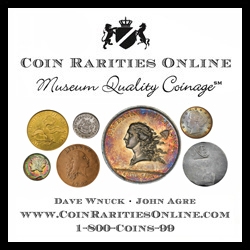
- Colonial Coins & Tokens
- US Coins in Copper, Silver & Gold
- Rare Types & Key Dates
- Pattern Coins
- Private & Territorial Gold Coins
- Esoteric Numismatic Items
George Kolbe's ads will be the next to appear (I've been lax in getting back to him on the specifications, but we're working on it).
Many thanks to our advertisers for their support. Our web site with its 10,000+ article E-Sylum archive and weekly E-Sylum newsletter are free to all as our contribution to numismatic education. Please thank and support our advertisers for helping to offset some of our costs.
FANNING NUMISMATIC LITERATURE'S SECOND AUCTION PRICES REALIZED AVAILABLE
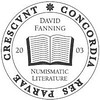 David F. Fanning's second mail-bid auction sale closed on Thursday, June 4. The prices realized are available on the firm's Web site at www.fanningbooks.com .
David F. Fanning's second mail-bid auction sale closed on Thursday, June 4. The prices realized are available on the firm's Web site at www.fanningbooks.com . Some highlights include:
- Lot 223 (photographs and negatives depicting coins from the Waldo C. Newcomer collection: $4500
- Lot 73 (1702 folio of Charpentier et al. on medals of Louis XIV, with the extremely rare suppressed Preface): $4000
- Lot 75 (1723 folio of Charpentier et al.): $4000
- Lot 315 (Fisher's 1837 description of American medals): $2700
- Lot 145 (1709 Act of Queen Anne, regulating the value of foreign coins in America): $1600
- Lot 186 (Groux's 1856 Prospectus): $1000
- Lot 493 (Wayte Raymond's hardcover copy of his 1939 sale of coins from the Newcomer collection, with various inserted materials): $900
We thank everyone who participated in the sale. Auction III is tentatively scheduled to close on Thursday, December 3, 2009. David Fanning can be reached at (614) 256-8915 or at dfanning@columbus.rr.com
NEW BOOK: THE ART OF MAKING MONEY: THE STORY OF A MASTER COUNTERFEITER
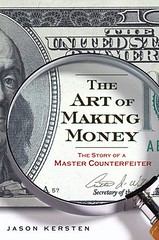 When the Federal Reserve Bank debuted a redesigned $100 bill in 1996, it was trumpeted as the most high-tech, counterfeit-proof currency to date. It took Art Williams four months to produce a convincing duplicate of it.
When the Federal Reserve Bank debuted a redesigned $100 bill in 1996, it was trumpeted as the most high-tech, counterfeit-proof currency to date. It took Art Williams four months to produce a convincing duplicate of it.Williams' forgery wasn't the first copy of the new c-note - others had emerged on the black market while he was serving a prison sentence. But his was among the best available, and caused a stir among his associates in Chicago's criminal underground, who immediately placed orders for hundreds of thousands in bogus dollars.
Even before the $100 bill's redesign, counterfeiting was considered one of the most difficult criminal endeavors, and an ancient, nearly forgotten art. The new c-note, with its color-shifting ink and special chemical composition that responded to a counterfeit-detecting pen, presented challenges that intimidated more experienced counterfeiters than Williams.
But Williams' persistence was matched only by his ingenuity in defeating the bill's security measures, often finding the answers in unexpected places. (He discovered that paper from the telephone book passed the pen test. He mimicked the ink with automotive paint and a rubber stamp.)
"The Art of Making Money" is reminiscent of con-men stories, such as Frank Abagnale's con-artist memoir, "Catch Me If You Can," or "Bringing Down the House," Ben Mezrich's tale of card-counting students.
To read the complete article, see: 'Making Money' worthy con-men book addition (www.bradenton.com/entertainment/story/1491161.html)
NEW BOOK: GOBRECHT JOURNAL COLLECTIVE VOLUME #5
 A final review copy of the new Collective Volume Number Five has been approved and 150 copies of the book have been ordered. The printing company has to place the order into its printing schedule and I have been told that the books will be available for delivery by June 15th. I will therefore deposit the checks that I have received from orders so that I can pay the printer upon delivery of the books.
A final review copy of the new Collective Volume Number Five has been approved and 150 copies of the book have been ordered. The printing company has to place the order into its printing schedule and I have been told that the books will be available for delivery by June 15th. I will therefore deposit the checks that I have received from orders so that I can pay the printer upon delivery of the books.Assuming that the books are received on the delivery date they will be sent Media Mail to individuals who have ordered copies. Shipping will therefore take about a week. We have currently received 137 orders for the volume so it will take some time to package up and mail out all of the books. Orders will be sent out as quickly as possible but the task will take a while.
Unfortunately, I don't have a copy of the order form, so I'm not sure where orders should be directed. If anyone wants to place an order, let me know and I'll get the information for you. -Editor
NEW E-BOOK: THE HOBO NICKEL BY JOYCE ANN ROMINES
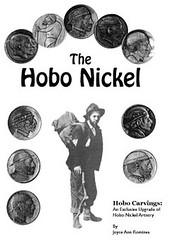 Stella Coin News is very pleased to announce their 9th numismatic online reference book, The Hobo Nickel an Exclusive Upgrade of Hobo Nickel Artistry by Joyce Ann Romines. Published in 1996 after 17 years of research and study, is now available to all collectors free of charge. SCN was given permission to reproduce the reference material online.
Stella Coin News is very pleased to announce their 9th numismatic online reference book, The Hobo Nickel an Exclusive Upgrade of Hobo Nickel Artistry by Joyce Ann Romines. Published in 1996 after 17 years of research and study, is now available to all collectors free of charge. SCN was given permission to reproduce the reference material online.This is an updated and republished version of Del Romines original publication "The Hobo Nickel". This addition is fully illustrated and very informative from the extensive studies that were conducted on these fabulous carvings
To read the e-book, see: The Hobo Nickel (www.stellacoinnews.com/index.php/reference-books/the-hobo-nickel/)
THE BOOK BAZARRE
BOOK REVIEW: TEUTENBERG: A MASTER ENGRAVER AND HIS WORK
This numismatic catalogue was offered as a companion piece to a Teutenberg restrike commissioned by the Numismatic Society of Auckland to commemorate the fiftieth anniversary of the Society on May 2, 2009. -Editor
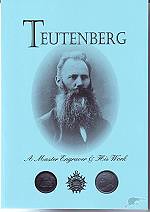 Anton Teutenberg was a German migrant who became a prominent sculptor, engraver and medal-producer in New Zealand during the late nineteenth and early twentieth century.
Anton Teutenberg was a German migrant who became a prominent sculptor, engraver and medal-producer in New Zealand during the late nineteenth and early twentieth century.With some interruptions along the way, the Numismatic Society of Auckland (NSA) has documented the work of Teutenberg, who retired and sold his business during the First World War, and died in 1933, and acted as a guardian of his numismatic legacy, since the mid-1960s.
This 2007 book is a catalogue of known works by Teutenberg and is prefaced by both a biographical sketch of the sculptor and an accounting of the mishaps in the custody of the artefactual legacy of Teutenberg! Both of the former prefaces are entertaining reads.
85 photographic plates document Teutenberg's known works and the soft cover volume is a pleasure to find in hard copy, published by Mintmark, the NSA's periodical arm.
The companion medal restrike takes a Teutenberg die from an 1897 Jubilee medal originally issued to winners of a military athletic tournament. Using the master die held by NSA, the commemorative restrike produced 45 silver, 45 copper and 7 gold medals each bearing the reverse legend: Numismatic Society of Auckland (Inc.) 1959-2009
Although I have never visited the Antipodes, owning this work has charged my enthusiasm for collecting numismatic works from down under. I expect to find more Australian and New Zealand books and coins in my collection as a result of reading this rigourous and entertaining volume.
BOOK REVIEW: THE NEIGHBORHOOD MINT: DAHLONEGA IN THE AGE OF JACKSON
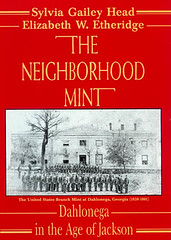 In our April 26, 2009 issue (v12n17) we ran an announcement of the new edition of a classic book on the Dahlonega Mint, The Neighborhood Mint: Dahlonega In the Age of Jackson.
In our April 26, 2009 issue (v12n17) we ran an announcement of the new edition of a classic book on the Dahlonega Mint, The Neighborhood Mint: Dahlonega In the Age of Jackson.From the earlier E-Sylum article:
Al kindly sent me a review copy and I spent some time getting reacquainted with this great book; I have the original edition on my shelves but frankly, hadn't opened it in years (my wife and kids have nudged numismatics far down the priority list).
There are some GREAT stories in here, all based on original source material in the National Archives and elsewhere. It's a delightful account of a misfit mint, plagued with construction problems and delays, beset with a dwindling local gold supply and suffering the ignominy of its high-quality coin output rarely entering circulation locally.
From the Preface:
The Dahlonega Branch Mint cost far more to run than its meager production of gold coins warranted. It survived for almost a quarter century not because it was efficient or served any really useful purpose but because it was politically popular.
Also covered are the mint's gold coinage years of 1838-1861 and its closure in 1861, brought on by the beginning of the Civil War. The treasure trove of information that forms the foundation of the book's research is the Correspondence of the Mint of the United States at Philadelphia with the Branch Mint at Dahlonega, Georgia, 1835-1861, obtained from the National Archives in Washington, D. C.
What makes The Neighborhood Mint so special are its flowing narrative, rich character studies of the mint personnel and townspeople of Dahlonega, and the ¡°you are there¡± feeling that it imparts to the reader. One cannot help but gain a sympathetic understanding of the difficulties of the mint personnel, who were faced with all manner of uncertainty, both internal and external, not the least of which was the ever-changing political landscape. All of this is sure to delight history lovers, Dahlonega Mint aficionados, and anyone who likes a good story.
Gold Rush Gallery is having this volume reprinted because we feel that it is a very important historical work. At the same time, copies of this out-of-print book are extremely difficult to find in the numismatic and antiquarian literature markets. As the word ¡°reprint¡± implies, we have left the original text and photographs unchanged. However, with the authors' permissions, we have taken the liberty of adding four high quality plates, to make this reprint edition special in its own right.
The first plate is the only-known, full-view photograph of the Dahlonega Mint, discovered in October 1997. Many dedicated numismatists and historians had searched for this breath-taking image during the twentieth century. Plates two and three consist of color photographs of a complete nine-piece type set of Dahlonega gold coins, illustrating all of the major design types produced at this historic mint. Plate four is a drawing of a toggle-joint steam coining press, of the type used at Dahlonega. We hope that the reader enjoys this great book and that its reprinting will be a boon to present and future numismatists and historians.
To read the earlier E-Sylum article, see: NEW EDITION: THE NEIGHBORHOOD MINT: DAHLONEGA IN THE AGE OF JACKSON (www.coinbooks.org/esylum_v12n17a09.html)
REVIEW FOLLOWUP: WORLD'S GREATEST MINT ERRORS BY MIKE BYERS
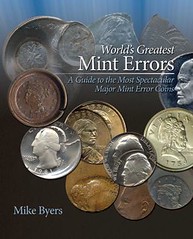 I first reviewed World's Greatest Mint Errors by Mike Byers in the April 5, 2009 E-Sylum (v12n14). Follow the link below to see the full review, where I wrote:
I first reviewed World's Greatest Mint Errors by Mike Byers in the April 5, 2009 E-Sylum (v12n14). Follow the link below to see the full review, where I wrote: My review was based on an electronic copy of the text sent to me by Jessica Mullenfeld of Zyrus Press. I wrote:
Well, a review copy of the printed book arrived a couple weeks ago, and I can report that the images look good in print as well. Printed on sturdy glossy paper, the book is coffee-table sized, something that wasn't readily apparent from the electronic copy. Could the images be improved? Perhaps, although I'm no expert in coin photography. Maybe I was spoiled by the online images, which glow brightly on a computer screen. Reader opinions are welcome.
I added the book to the error shelf in my library and I'll stand my earlier remarks:
To read the earlier E-Sylum article, see: BOOK REVIEW: WORLD'S GREATEST ERRORS BY MIKE BYERS (www.coinbooks.org/esylum_v12n14a03.html)
BOOK REVIEW: A GUIDE BOOK OF U.S. COINS, 2010 LARGE PRINT EDITION
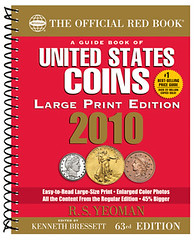 In our May 10, 2009 issue (v12n19), Dennis Tucker submitted a press release on the new large print edition of the classic "Red Book", A Guide Book of United States Coins.
In our May 10, 2009 issue (v12n19), Dennis Tucker submitted a press release on the new large print edition of the classic "Red Book", A Guide Book of United States Coins.From the press release:
"The new Large Print Edition Red Book is 45% larger than the regular edition," said Whitman publisher Dennis Tucker. "It has bold, easy-to-read print, and every photograph is enlarged in high detail. The book includes all the content of the regular edition¡ªevery price, mintage, and specification, and all the historical background text."
At that time I wrote:
Dennis was kind enough to send a review copy, and I'm quite grateful. The large-print spiral-bound version is to me a great improvement over the standard version. I do find it much easier to read and use. You young whippersnappers out there can giggle and point if you want to, but the large print version will be this old numismatist's format of choice.
I can read it easily and the larger images are suburb. I like them better than the images in the Byers error book discussed above, although again, I'm no expert on coin photography.
I pulled out my 1949 and 2007 editions for comparison and sure enough, I could easily read the 1949 but had trouble with 2007. I think my earlier suspicion in correct - had the book's profile grown along with its content over the years, the result would be similar to what we see in the large print edition (just not QUITE as large).
To read the earlier E-Sylum article, see: NEW BOOK: LARGE PRINT EDITION OF THE 2010 "RED BOOK" (www.coinbooks.org/esylum_v12n19a06.html)
DICK JOHNSON ON CUTTING UP COIN BOOKS
As a teenager, I read Albert Frey's Numismatic Dictionary. I adored that book. I surmised that by reading this I could learn the "language of numismatics." I went one step further. I bought two additional copies, tore off the cloth covers and cut the pages apart.
I had a little home print shop, where I bought paper wholesale. I bought sheets of Bristol card stock in five or six colors, cut these into 4 by 6 inch size and made a card file. I cut apart each term and definition from those loose pages of Frey's dictionary and pasted down those printed entries on these index cards.
I color-coded the definitions. Green obviously was for paper money terms, pink for coin denominations -- there were move of these in Frey than any other category -- blue was for technical terms, and salmon I believe was for odd and curious money. White was for non-numismatic terms, Frey included some economic terms as well.
My intent was -- even as a teenager -- to study these cards and add definitions from other sources. I even printed a line at the bottom of the card as a "source line" where I found the definition. I located a couple of other numismatic books with Glossaries and copied these entries on the color-coded cards. Then I went off to college and this project was set aside.
The technology blue cards were my favorite. These were the terms real numismatists used. [Little did I realize then that exercise was to spur me into compiling a list of numismatic terms, mostly technical, sixty years later, now on computer and number at present 1,834.]
Glossaries I have since learned are uneven. These are snapshots of numismatic terminology mostly for newcomers to learn the meaning of unfamiliar terms. The best is found in Breen's Encyclopedia of U.S. and Colonial Coins. The worst are on the internet today. These often have misinformation, compiled by coin enthusiasts without any real technical understanding of what they are writing about. They heard the term and they think they know what it means, often incorrect.
Well, I am still cutting apart numismatic books. Earlier this year I bought a second copy of Katie Jaeger's Guide Book of United States Tokens and Medals. I wanted to annotate my copy, but Whitman didn't leave much room in the margin for my marginalia notes. I often talk back to authors, expressing agreement or disagreement with their statements. Or add other comments, sometimes indicating animal excrement, "What a bunch of B.S." I must state there is none of that, however, in Katie's tome.
I had a local printer guillotine the glued spine off this paper-covered book. Now I have 286 loose pages that I can photocopy in color on pre-holed 3-ring notebook paper. I can annotate to my heart's content. And gather these up in a notebook.
Trouble is I have 286 loose pages. Any body got a box that just fits a Whitman Red Book series?
NOTES ON POOR BOOK BINDINGS
At that point I bought yet another copy and immediately took it apart. I used a comb-binding machine and laminated paper covers to reassemble it by chapters, and these sections have served me well ever since. It's actually much more convenient to retrieve the desired chapters individually, as needed.
Another book that quickly fell apart with only moderate use was Ronald Manley's wonderful reference The Half Cent Die State Book. I use this exclusively for attributing half cents, due to its excellent plates. The pages of my copy fell out quite easily, and I again solved the problem with do-it-yourself comb binding. I didn't bind it with new covers, as the cloth covers of the original binding remained securely attached to one another. I simply use the original cloth as a slipcover for the rebound pages, which works just fine.
The original edition of my Buffalo Nickel book was published only in perfect-bound softcover, but I had requests for hardcover copies. The late Dave Feigenbaum, founder of DLRC Press, put me in touch with the binder he used for the hardcover copies of his titles, and this seemed like a cost-effective solution. Unfortunately, in my naivete I didn't realize that simply cutting away the spine from a paperback and gluing the pages directly to cloth would not make for a very durable binding.
One dealer even told me that the reason he wouldn't buy a hardcopy from me was that the pages would soon begin to fall out of such a binding. Nevertheless, I had several dozen copies bound that way in red, brown and black cloth, and these found ready buyers. Of course, I've never seen one of these reappear at auction or in a numismatic bookseller's inventory, and I suspect that they may have indeed succumbed to regular use and fallen apart. My own sample copies were placed into a bookcase and retired, so I don't have firsthand experience in using them. Subsequent editions were offered in hardcopy only and with more durable bindings as made.
FRED REED OFFERS ENCASED POSTAGE BOOK "TRUE FIRST EDITION"
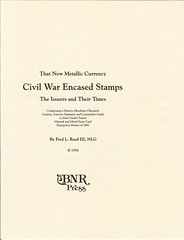 I was cleaning out a storage facility and came across four boxed sets of unbound first edition signatures printed on oversize paper of my award winning book Civil War Encased Stamps: the Issuers and their Times.
I was cleaning out a storage facility and came across four boxed sets of unbound first edition signatures printed on oversize paper of my award winning book Civil War Encased Stamps: the Issuers and their Times.This is the true FIRST EDITION printed by R.R. Donnelley in Houston, Texas in late 1994 to satisfy the ANA deadline that the book be published within a time certain in accord with the $5,000 research grant they gave me.
As most readers of The E-Sylum know the book on their shelves, which received widespread acclaim and ultimately won many numismatic and philatelic awards (incl. NLG "Best Book", a lifetime achievement award from Krause Publications and SPMC, and international philatelic gold and gold vermeil medals), is the 550-page 1995 book in green covers with the fancy dust jacket.
The 1994 book was necessarily VERY RARE. It was published as 484 pages, to the extent of 22 copies only. Five were bound in brown covers. Two were sent to the American Numismatic Association to fulfill my obligation to them, and also so that then Executive Director Robert Leuver could write a blurb for the back cover of the 1995 revised first edition dust jacket. One was sent to BNR publisher Fred Schwan, and I retained two bound copies, which remain on my shelves today.
This would make a nice item for the bibliomaniac since virtually nobody has a copy, errors appear which were corrected in the subsequent printing, and especially topical since a revised second edition of the book is now nearing completion.
Of the remaining unbound copies, I gave several away over the years, sold several to interested collectors, and destroyed about a half dozen in 2002 cleaning out another storage facility. I wish I hadn't destroyed those copies then, but I believe these to be the last four remaining of the unbound original 17. Consider this a pattern or "trail strike" of the 1995 book.
Readers of The E-Sylum can have one for $75 (plus $9 shipping and insurance) while the four copies remain. Contact fred@spmc.org for information on ordering. A detailed back story on how, when and under what conditions this first edition came to be published will be furnished book buyers.
ANS SEEKS INPUT FOR LIBRARY DIGITIZATION PROJECT
We are now in the planning stage of a large project to digitize items in our Rare Book Room and to make them available for a fee in a digital format to those unable to visit the library itself.
Obviously this is a considerable undertaking, and our resources are limited. So we must prioritize which items we scan first according to where the greatest interest lies. We would be very grateful to you and your E-Sylum readership for suggestions as to desirable subjects for digitization in the first phase of the project (2009-2014).
We might, for example, target the series of 19th and early 20th century auction catalogues of the Chapmans or Lyman Low. But there may also be individual works that we should consider too. What suggestions does your readership have?
QUERY: WHAT INFORMATION WAS FIRST PUBLISHED IN DYE'S ENCYCLOPEDIA?
Speaking of digitization, Tom Kays has some interesting questions about a book he recently found online. He writes:The rise of money in world cultures at the beginning is really great and the detail in the colonial section rivals recent scholarly publications regarding 1749 half pence of the H.M.S. Dolphin, the various Machin's Mills including how the press became ballast on the ship Newburgh, and street addresses of the colonial mints.
Was this the first compilation of such information or does it rest on the laurels of earlier numismatic research? The back half surveys modern world coins circa 1880 and for fifty years prior, which I know was already investigated and reported by folks at the Mint on a periodic basis, such as the extended report of 1827 and subsequent years. Steel engravings of the mint buildings including Charlotte and Dahlonega also appear in back.
What information was first published in this Encyclopedia? Does anyone have the back few pages with the bibliography?
There's a lot of great information in these pioneering books, and not all of it has been republished elsewhere.
As for what information FIRST appeared in Dye's Encyclopedia, I'm curious to hear our readers' thoughts. Crosby's classic on The Early Coins of America was published in 1875 and likely was a source for some of Dye's text, but I haven't done any comparisons. -Editor
MORE ON COIN PHOTOGRAPHER LARRY STEVENS
Regarding last week's obituary of coin photographer Larry Stevens, Julian Liedman writes: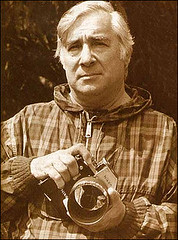 My relationship with Larry Stevens can best be described as love-hate. The hate came first.
My relationship with Larry Stevens can best be described as love-hate. The hate came first. I was aware of his amazing ability as a photographer and his specialty of photographing numismatic items, events and institutions. In the 1950s I was compiling all the details I could find on the medallic works of Victor D. Brenner. My research uncovered the family collection of Brenner's works, known as the "Jaspon Litt collection."
I learned Jaspon Litt was a real person who worked for the Social Security department of the government and lived in Baltimore. I had made arrangements with him to examine the collection and to photograph it. I asked Larry Stevens if he could join me at the time and photograph all the items.
He agreed. I paid him half his fee in advance. A week or two later the prints arrived of all the shots he took of the Brenner medals. I paid the remainder of his fee. I assumed I had exclusive use of those photographs.
How wrong I was. Within months those photographs started showing up in COINage magazine. I screamed at both COINage and at Larry Stevens. Without a contract he claimed ownership of the negatives and could sell them to whomever he chose and how often he choose. It soured me on both parties and the project.
The good news is that the Jaspon Lit collection eventually was donated to the American Numismatic Society -- where it should have gone -- and remains intact today. I was hired to appraise the most spectacular piece in the collection, a three-foot plaster model of Lincoln, a la the Lincoln cent.
Earlier, in 1967, when I was a recent employ of Medallic Art Company, Larry wrote MACO president, William Louth, if he could come do a photo shoot of the plant. Bill agreed and assigned me to assist him. Not one to carry a grudge, I complied and even wrote the text for the COINage story, "Home of the Art Medal" illustrated with all of Larry's photographs. [COINage, December 1967, 3:12, p 26-29]
Medallic Art ordered reprints from COINage of that article, twice I believe, as we handed them out fairly freely. So my approbation of Larry Stevens increased.
Over the years, however, I tried to get prints from those negatives he had, but he refused even to answer my letters. My last appeal was April 4, 2005.
There was a rumor that numismatic photo guru Bill Nawrocki of Chicago had Larry's negatives and was his agent for sales of the photos from those negatives. I contacted Bill. Not true.
It was obvious Larry had stopped photographing in the numismatic field. We heard he had found an interest in carving bird models. But he must have felt disappointed in the numismatic field because he severed ties with those who could have used his services. Too bad.
Now, after his death, those files of his numismatic negatives are extremely valuable to the numismatic field. I hope they have not been destroyed. But I should state they can only be used by another professional photographer. Reason: when Larry would photograph a round coin or medal he would tilt it slightly at a fixed angle. The image on the negative is an oval.
Only he made prints from his negatives. On his enlargement stand he would also have the print paper board tilted at an angle to compensate for this. Thus the prints would show a perfectly round coin or medal. But not everyone can do this from his negatives.
I learned one-time Stack's photographer, Robert Meyers, did the same thing. (He not only photographed some of my medals he was also my auctioneer.) It has something to do with reducing glare from a coin's reflective surface I guess. Sorry, I am not a photographer; I don't understand the reason for this technique.
THE BOOK BAZARRE
FBI RETURNS MEDALS RECOVERED FROM EL BUEN CONSEJO TO ANGUILLA
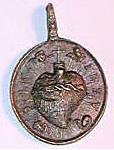 The problem with stolen art is that once you start to sell it, word gets out. When the art involved is a hundred or more bronze religious medallions, each worth perhaps $1,000, eventually somebody will notice, call the FBI, and there go the profits.
The problem with stolen art is that once you start to sell it, word gets out. When the art involved is a hundred or more bronze religious medallions, each worth perhaps $1,000, eventually somebody will notice, call the FBI, and there go the profits.Which is apparently what happened with a haul of bronze medallions that took a 237-year journey from Spain to Anguilla to Vermont and then back to the Caribbean.
Shortly after midnight on June 8, 1772, the Spanish vessel El Buen Consejo smashed into Anguilla in the Leeward Islands, stranding passengers and crew on a voyage to Mexico.
The ship and an accompanying vessel, El Prusiano, sank, with their cargoes. The lost goods included thousands of bronze religious medallions carried by 50 Franciscan priests who were bound for the Philippines and meant to be used to win converts and for educational purposes.
On Tuesday, more than 100 of the medals were returned to the government of Anguilla by the U.S. Federal Bureau of Investigation. The FBI said it had assisted Anguillan authorities in recovering the medallions, which are considered to have "international archaeological significance." Under Anguillan law, such goods are not supposed to leave the country.
To read the complete article, see: FBI Returns Medallions Plundered From 18th-Century Shipwreck (www.artinfo.com/news/story/31627/fbi-returns-medallions-plundered-from-18th-century-shipwreck/)
CARSON CITY COINAGE SYMPOSIUM AT 2009 ANA CONVENTION
Regarding his research query last week, Rusty Goe writes:On another note, I have attached a press release about the Carson City coin symposium that our club (Carson City Coin Collectors of America) is sponsoring at this year's ANA World's Fair of Money in Los Angeles. I realize that there's a conflict schedule with the C4OA symposium and the NBS meeting, but I thought your subscribers might want to hear about our symposium anyway.
Do you enjoy learning about the Carson Mint's history and its coinage? Come join the Carson City Coin Collectors of America at its
In conjunction with the C4OA's annual meeting. Special guest speakers include:
- Bill Bugert Diagnostics for 1875-CC Half Dollar Die Marriages
- Darrell Low An Overview of Liberty Seated Coins from the Carson City Mint
- John McCloskey An Introduction to Gold Half Eagles from the Carson City Mint
- Rusty Goe Harold M. Budd¡ªAmbassador of ¡°CC¡± Coinage in First Half of 20th Century
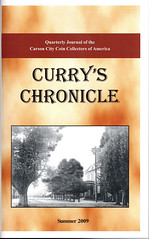 Date: Thursday, August 6, 2009
Date: Thursday, August 6, 2009 Time: 1:00 ¨C 3:00 p.m.
Location: The Los Angeles Convention Center, room No. 512
Rusty Goe founded the Carson City Coin Collectors of America in May 2005. Over 445 "CC" coin enthusiasts have signed up for membership as of June 2009. Subscriptions are $20 per year, which entitles members to receive four issues of the club's award-winning journal, Curry's Chronicle. Over 165 articles about the Carson City Mint and its coins have appeared in the journal to date.
Questions: mariesgate@sbcglobal.net, or 775-322-4455
Web site: www.carsoncitycoinclub.com
1876-CC TWENTY CENT PIECE PUBLICITY
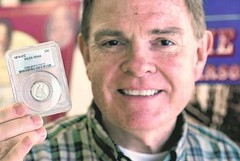 In my right hand I held a pair of dimes. Small change. Hard to think what they'd buy today.
In my right hand I held a pair of dimes. Small change. Hard to think what they'd buy today.In my left a small silver coin stamped "twenty cents". As legal tender it's the equivalent of the dimes. When it was minted it was worth slightly less than $4 dollars in today's money and might have bought a modest meal. Today it's worth a half million dollars, perhaps more.
A half million is what Reno coin collector and dealer Rusty Goe paid for the coin at auction recently, his second try at an elusive and expensive prize.
What makes this small silver coin worth that amount? Two words: rarity and competition.
Ten thousand of these coins were struck at the Carson City mint in 1876. Unpopular with American consumers the denomination was discontinued and most were melted down. Goe figures there are maybe 18 out there. Their rarity the obvious reason for the value and in the world of coin collecting scoring coins like this are like finding the Holy Grail. But Goe says it's much more than that.
"Once you learn the history of how they were introduced into our monetary system. And then you hear the back story of how the coins came down to us over the last 133 year, you begin to see how important they are. These are relics from the past. These are like small, little antiques."
To read the complete article, see: Reno Man Buys 20-Cent Coin For Half-Million (www.kolotv.com/home/headlines/46990917.html)

INDIAN PEACE MEDAL PRESENTED TO CHEROKEE IN COLONIAL WILLIAMSBURG
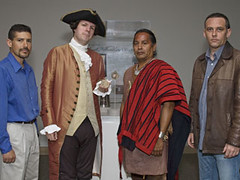 Costumed interpreter Jeffrey Villines presented a replica of a rare 1780 Indian Peace Medal to John Standing Deer Jr., cultural ambassador of the Eastern Band of Cherokee, who accepted the medal May 12 on behalf the Museum of the Cherokee Indian. At far left, is Erik Goldstein, Colonial Williamsburg's curator of mechanical arts and numismatics. At far right, is Buck Woodard, manager of Colonial Williamsburg's American Indian Initiative.
Costumed interpreter Jeffrey Villines presented a replica of a rare 1780 Indian Peace Medal to John Standing Deer Jr., cultural ambassador of the Eastern Band of Cherokee, who accepted the medal May 12 on behalf the Museum of the Cherokee Indian. At far left, is Erik Goldstein, Colonial Williamsburg's curator of mechanical arts and numismatics. At far right, is Buck Woodard, manager of Colonial Williamsburg's American Indian Initiative.Early this year, the foundation acquired the original medal produced by order of Gov. Thomas Jefferson in 1780. The medal is currently exhibited in the introductory gallery of the DeWitt Wallace Decorative Arts Museum.
Commemorating an unidentified Revolutionary-era alliance between Native tribes and the Commonwealth, the "Happy While United" peace medal was cast in bronze by Robert Scot ¨C later chief engraver at the U.S. Mint ¨C in Williamsburg or Richmond.
To read the complete article, see: Peace Medal presented to Eastern Band of Cherokee in Colonial Williamsburg (indiancountrytoday.com/living/tourism/46723532.html)
KING WILLIAM III SIXPENCE FOUND IN MASSACHUSETTS
 Peter Burgess, a retired psychologist, who found a strange-looking coin on his property last spring, recently discovered it was over three hundred years old.
Peter Burgess, a retired psychologist, who found a strange-looking coin on his property last spring, recently discovered it was over three hundred years old."At first, I wasn't sure what it was," said Burgess. "It didn't look so much like a coin, but like a brown wafer."
Upon further study, Burgess noticed small markings on the coin: a crown, three lions and some numerals. The coin turned out to be an approximately 313-year-old English silver sixpence, which was issued only during the reign of King William III, who ruled over England from 1689 to 1702, according to researchers.
"It's a pretty significant find," said Dan Sanders, a Truro Historical Society historian and retired physicist, who is also a friend of Burgess. "It's one of the earliest coins I've ever seen on Cape Cod, and it's right where the town was founded."
Sanders said it's unusual to find an English coin from this period on Cape Cod. "It's rare that an English coin of this kind would be in the Colonies," he said. "Mostly at that time they used Colonial coinage, if any. Most people of that time and place were self-sufficient. It was very much more a bartering society."
Though not worth much money to collectors, the coin holds historical value to Truro and the rest of the Cape, Sanders said.
Burgess spent several months researching the coin online, before he contacted Louis Jordan, director of Special Collections department at the University of Notre Dame, who definitively identified the coin.
To read the complete article, see: Cape man finds 313-year-old sixpence (http://www.boston.com/news/local/breaking_news
/2009/06/_the_valuable_o.html)
Tom Kays researches colonial and pre-colonial era coins dug up in the U.S., so I asked him about the article's assertion that "It's rare that an English coin of this kind would be in the Colonies". Tom writes:
Pound/shillings/pence continued in use as money of account in New England to about 1835. It was not cricket to export gold and silver coin of the realm in large quantities for commercial purposes, but in service to His Majesty, it could and did walk away in small amounts with soldiers and sailors. Such coins were seen in America and Canada but did not dominate daily commerce with a preponderance of numbers.
I asked Lou Jordan as well, and he writes:
Apparently the local historian was asked about the find. Much of what he says is incorrect. In fact, I recently wrote a long article in the St. Patrick's COAC volume discussing all of the coins in circulation in British America from the earliest settlements to ca. 1660 (just before the St. Pat's arrived in NJ) and several English coins were included in the documents and have been recovered in controlled archaeological digs.
So, to some degree English coinage was found in America, and during the first half of the 18th century William III silver did circulate (both regal and counterfeit). It certainly was not as common as Spanish-American silver but it would not be unknown by any means! By the way, that specific coin could have been deposited at any point during the 18th century (or possibly even later!).
1759 edition of Father Abraham's Almanack by Abraham Weatherwise of Philadelphia lists the English sixpence coin (6d) as one of the items that circulate. And obviously, the table was limited to coins that would turn up with some frequency.
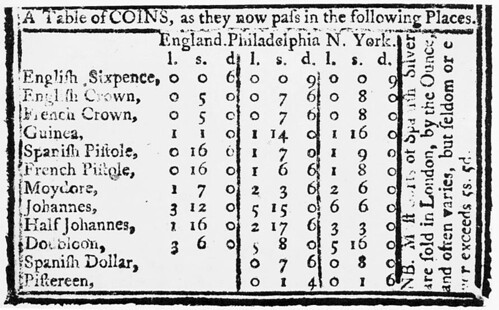
LAS VEGAS BUSINESSMAN FACING JAIL FOR GOLD COIN TAX SCHEME
But attorney William Cohan paints Kahre as an American "hero" who believes his payroll system helped keep the U.S. monetary system sound, and was also a form of legal tax avoidance.
According to the government, Kahre and others concocted a fraudulent cash payroll "scheme" and then peddled it to other Las Vegas contractors. Defendants did not report to the IRS any payments made to workers, "either at the true amount or at the bogus amount, ... being the face value of the coin or coins," according to the indictment.
The now-suspended payroll service handled about $114 million over six years, according to court records. Between 17 and 25 percent of that went to Kahre or his workers; the rest went to the 35 client businesses to pay their workers, court records show.
Kahre contends his workers had agreed to be independent contractors, so he did not have to withhold taxes for them. His six businesses are in the trades of painting, drywall, tiling, plumbing, heating-cooling and electrical work.
Further, the $50 gold coins and the silver dollars Kahre used for payroll are designated by Congress as legal tender, so people are entitled to value them at their stamped denominations, he also contends. Taken at face value, each defendant's annual coin income placed him below the threshold for filing a federal tax return.
To read the complete article, see: Employer's gold, silver payroll standard may bring hard time (www.lvrj.com/news/46074037.html)
ROYAL CANADIAN MINT CAN'T ACCOUNT FOR MISSING PRECIOUS METAL
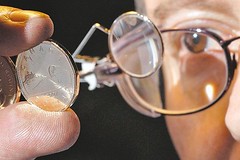 A significant quantity of gold, silver and other precious metals is unaccounted for at the Royal Canadian Mint.
A significant quantity of gold, silver and other precious metals is unaccounted for at the Royal Canadian Mint.External auditors are investigating a discrepancy between the mint's 2008 financial accounting of its precious metals holdings and the physical stockpile at the plant on Sussex Drive in Ottawa.
The mystery raises possibilities from sloppy bookkeeping to a gold heist.
Officials with the commercial Crown corporation are saying little and refuse to confirm the amount and value of the unaccounted for gold, silver and palladium.
"We're taking this very seriously. We're conducting a thorough review and we're expected to have that completed within the month. (It) includes the analysis of precious metal by-products and financial data. We've allocated all necessary resources to this review."
She stressed police have not been called into what mint officials consider an internal matter. She would not say whether the gold and other metals in question were part of the refinery and bullion operation or one of the mint's three other business lines: producing Canadian circulating coins, designing and producing coinage for foreign countries, and numismatics.
"We're looking at many different angles right now," she said.
To read the complete article, see: Mint can't account for missing gold (www.calgaryherald.com/Business/Mint+account+missing+gold/1656084/story.html)
ROYAL CANADIAN MINT'S TRIANGULAR HOLOGRAPHIC GUITAR PICK COIN
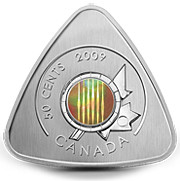 The Six String Nation Guitar is the brainchild of Canadian broadcaster Jowi Taylor and his vision to create a national story-telling symbol. As an acoustic masterpiece, this instrument of unity evolved to contain 64 pieces of Canadiana treasures including a piece of Bluenose II's deck, gold from Maurice Richard's Stanley Cup ring and some of the oldest rock on the planet from Great Bear Lake in the Northwest Territories.
The Six String Nation Guitar is the brainchild of Canadian broadcaster Jowi Taylor and his vision to create a national story-telling symbol. As an acoustic masterpiece, this instrument of unity evolved to contain 64 pieces of Canadiana treasures including a piece of Bluenose II's deck, gold from Maurice Richard's Stanley Cup ring and some of the oldest rock on the planet from Great Bear Lake in the Northwest Territories.On July 1, 2006, the guitar made its grand debut on Parliament Hill and since then, it has been played by several of Canada's top musicians. Now, a few years later, the Mint has worked closely with Jowi Taylor to create the historic Six String Nation Guitar coin. Given its interesting shape, theme and selective hologram featuring six vibrating strings, this 2009 50-cent coin is already proving to be a hot spring "pick" for coin collectors and music lovers alike. Mintage is limited to 30,000.
ARMORED TRUCK DROPS MORE THAN $300,000
A Brinks armored truck inadvertently strewed more than a dozen bags of money on the ground in front of the Syracuse Antiques Exchange on Friday, according to Sgt. Tom Connellan of the Syracuse police department.
David Jenks, the owner of the antiques shop, and Hanson Herring, who had just gotten a haircut at a nearby barbershop, Cuttin Up, were the first to approach the bags.
Herring said at first he thought the bags merely contained garbage. Only when he began to inspect one did he realize, "Oh man, this is money."
The money was in all different denominations, from coins to $100 bills.
The two men then began to round up the bags and load them into plastic postal bins. Tim Taylor, an off-duty Syracuse police officer who happened to be browsing in Jenks' antiques shop, assisted them.
As word spread that hundreds of thousands of dollars lay in the street, people streamed out of passing cars and adjacent businesses. For the most part the gatherers cooperated in the recovery effort.
All told, the men recovered $276,160 divided among 14 bags.
But two bags containing some $60,000 are still missing.
Police said it remains unclear whether the missing bags fell from the truck at an earlier point along its route, or whether someone at the scene of the main spill managed to discreetly slip away with them.
As for the Brinks Co., Herring said it rewarded him with a T-shirt and a gold coin commemorating the company's 150th anniversary.
To read the complete article, see: Armored truck drops more than $300,000 (http://www.cnn.com/2009/US/06/02/new.york.money.returned/)
FEATURED WEB SITE: THE ENGRAVEYARD
This week's Featured Web Site is suggested by David Gladfelter: The Engraveyard: A salute to Tiny Pictures Made with Wavy Lines
http://lileks.com/money/
